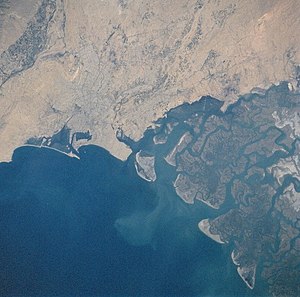| Revision as of 20:53, 11 October 2004 edit62.147.107.63 (talk)No edit summary← Previous edit | Revision as of 19:09, 12 October 2004 edit undoEgalitus (talk | contribs)314 edits Restructured and revised.Next edit → | ||
| Line 1: | Line 1: | ||
| ⚫ | The '''Indus (सिन्‍धु नदी)''' (known as '''Sindhu''' in ancient times) is the principal ] of ]. It originates in ], flowing from the ] in a north-westerly direction, and then turning south for nearly the entire length of Pakistan. The ] had some of the earliest urban settlements in the world. | ||
| ], near the rock Aornus.]] | ], near the rock Aornus.]] | ||
| == Course and Hydrology == | |||
| ⚫ | The '''Indus (सिन्‍धु नदी)''' (known as '''Sindhu''' in ancient times) is the principal ] of ]. It |
||
| === Course === | |||
| ⚫ | The ultimate source of the Indus is actually in ]; it begins at the confluence of the ] and ] that drain the ] and ] ranges. The Indus then flows northwest through ] just south of the ] range, then gradually bends to the south, coming out of the hills between ] and ]. It is dammed in this area also, forming the ]. The remainder of its route to the sea is in plains of the ] and ], and the river becomes slow-flowing and highly braided. Passing by ], it ends in a large delta to the southeast of ]. | ||
| ⚫ | === Tributaries === | ||
| ⚫ | |||
| ⚫ | The ], modern genetic studies show, lives both in the Indus River and in the ]. The two populations were formerly considered distinct species. It formerly occurred in the tributaries of the Indus also and may have extended into the northwestern extremities of the Indian Province of ]. | ||
| ⚫ | The Indus is one of the few rivers in the world that exhibit a ]. | ||
| ⚫ | Tributaries |
||
| * ] | * ] | ||
| * ] | * ] | ||
| Line 23: | Line 21: | ||
| * ] | * ] | ||
| === Other === | |||
| See also: | |||
| ⚫ | The Indus is one of the few rivers in the world that exhibit a ]. | ||
| == History and Archeology == | |||
| The ] was one of the oldest urban civilizations in the world. | |||
| == Wildlife == | |||
| ⚫ | The ], modern genetic studies show, lives both in the Indus River and in the ]. The two populations were formerly considered distinct species. It formerly occurred in the tributaries of the Indus also and may have extended into the northwestern extremities of the Indian Province of ]. | ||
| Located southeast of ], the large delta has been recognised by conservationists as one of the world's most important ecological regions. | |||
| == Related articles == | |||
| * ] | * ] | ||
| * ] | |||
| Line 31: | Line 40: | ||
| ==External Links== | ==External Links== | ||
| * The Changing Northern Areas ] | |||
| * Pakistan's Northern Areas dilemma] | |||
| * Northern Areas Development Gateway] | * Northern Areas Development Gateway] | ||
| * Pakistan's Northern Areas ] | |||
| * Northern Pakistan's Karakoram & Hindukush Mountains ] | |||
| * The Mountain Areas Conservancy Project ] | * The Mountain Areas Conservancy Project ] | ||
| Line 47: | Line 52: | ||
| ] | ] | ||
| ] | |||
| ] | ] | ||
| ] | ] | ||
Revision as of 19:09, 12 October 2004
The Indus (सिन्धु नदी) (known as Sindhu in ancient times) is the principal river of Pakistan. It originates in Tibet, flowing from the Himalayas in a north-westerly direction, and then turning south for nearly the entire length of Pakistan. The Indus Valley Civilization had some of the earliest urban settlements in the world.

Course and Hydrology
Course
The ultimate source of the Indus is actually in Tibet; it begins at the confluence of the Sengge River and Gar River that drain the Nganglong Kangri and Gangdise Shan ranges. The Indus then flows northwest through Gilgit-Baltistan just south of the Karakoram range, then gradually bends to the south, coming out of the hills between Peshawar and Rawalpindi. It is dammed in this area also, forming the Tarbela Reservoir. The remainder of its route to the sea is in plains of the Punjab and Sind, and the river becomes slow-flowing and highly braided. Passing by Hyderabad, it ends in a large delta to the southeast of Karachi.
Tributaries
- Gilgit River
- Gizar River
- Hunza River
- Gumal River
- Zhob River
- Kabul River
- Kunar River
- Sutlej River
- Beas River
- Chenab River
- Jhelum River
- Ravi River
Other
The Indus is one of the few rivers in the world that exhibit a tidal bore.
History and Archeology
The Indus Valley Civilization was one of the oldest urban civilizations in the world.
Wildlife
The Indus River Dolphin, modern genetic studies show, lives both in the Indus River and in the Ganges. The two populations were formerly considered distinct species. It formerly occurred in the tributaries of the Indus also and may have extended into the northwestern extremities of the Indian Province of Punjab. Located southeast of Karachi, the large delta has been recognised by conservationists as one of the world's most important ecological regions.
Related articles
External Links
- Northern Areas Development Gateway]
- The Mountain Areas Conservancy Project ]